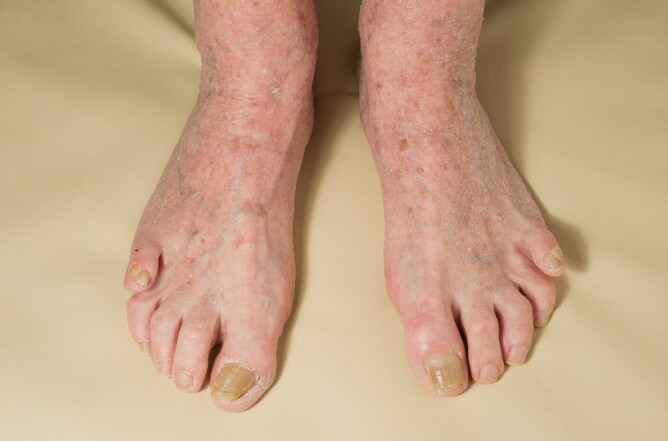Affecting up to one in four people, fungal nail infections are a frustrating problem that leave many struggling to restore the appearance of their nails for years. Starting as small, cloudy spots or streaks through the nail, fungal infections can progress to cover the entire toenail, leaving the nail with a thickened, tinged, moth-eaten - and generally unattractive appearance.
While some choose to ignore the problem in the hopes that it will naturally resolve, many are quick to head to the pharmacy to stock up on anti-fungal creams or lacquers, without realising that there’s a lot more than meets the eye when it comes to successfully treating the infection. From making sure that fungus really is the culprit of the changes you’re seeing to your nails, to ensuring your care goes beyond just the toenails, here’s what you must know if you want to get rid of a fungal nail infection for good.
Fungal Nail Infection: What Is It, Exactly?
Fungal nail infections occur when a fungal spore comes in contact with and infiltrates the nail, spreading by feeding on the keratin that nails are made of. As the fungus spreads, the appearance of the nail worsens, the colour of the nail changes and may become patchy, the nail can turn flaky, and it can develop a smell. This is the point where many turn to closed-in shoes and socks to hide their nails.
Here’s how a fungal nail infection may progress on a big toe:
Is It A Fungal Nail Infection, Or Something Else?
Fungal nail infections are estimated to account for 50% of all nail diseases, but what about the other 50%? A big problem with treating fungal nail infections is misdiagnosis. Specifically, assuming that the changes you’re seeing to your nails are caused by fungus, and not one of the other many conditions that creates similar symptoms and nail changes.
Having an unconfirmed diagnosis means you’re treating your toenails ‘blindly’ - spending time, money and effort on a remedy that may produce no results because it’s trying to treat a fungus that isn’t there. That’s why it’s very important to confirm your fungal nail infection diagnosis, which is easily done using a nail fungus testing kit, which are easy and convenient to have done during your appointment with us.
If it’s not fungus, the changes to your nails may be caused by:
- Psoriasis: also has nail discolouration, thickening, irregular ridges, the nail can come away from the nail bed, the nail may be ‘pitted’
- Onychogryphosis: a disorder of the nail where it significantly thickens, turns yellow-brown, may become flaky and more curved
- Nail trauma: damage to the nail from things like dropping something on the toe, which causes changes to the nail resembling a fungal nail infection
- Lichen planus: an inflammatory condition which can cause ridging, discolouration, brittleness and distortion of the nails which can resemble a fungal nail infection
Treating Fungal Nail Infections
Once your fungal infection diagnosis is confirmed and your action plan is provided, it’s time to treat your fungal nail infection. The two most common treatment options are topical serums and oral medications. We typically do not recommend trying oral medications as a first-line treatment because of the significant risk of side effects, paired with these medications being unsuitable for many that have other medical conditions, are taking certain medications, or have compromised liver function.
We see fantastic results using specific nail serums, so often recommend these in the first instance - they also have few contraindications or risk of side effects. Your progress is measured via digital photography, and timely advice will be provided as your nail grows and we see how it is responding to treatment.
If your results show that the changes to your nails are not from a fungal infection, we’ll let you know the best next steps you can take to address the appearance of your nails, based on how severely your nails are affected and what the likely problem is.
The Step Most People Miss When Treating Fungal Nails
As fungus travels through tiny spores, the spores will be present on the skin of your feet, your socks, your shoes, your bedsheets - even the surface of your shower. This is why treating only the affected toenails is often not enough to fully eliminate the fungus - or keep it gone for good. You must also treat your environment, which can look like:
- Anti-fungal aerosol spray within your shoes
- Anti-fungal foot cream
- Hot washing your bed sheets and socks with anti-fungal detergent
- Disinfecting your shower and other surfaces where you spend time in bare feet.
This and more information will be provided with your treatment plan to ensure you have the highest chance of success. If you don’t take care of your environment, then you risk reinfecting your nails from the spores lingering in your environment.
Ready For Healthy, Beautiful Nails?
All treatment plans and monitoring are conducted by our registered podiatrists and are designed to help you get the best results and keep your feet safe and free from nail fungus. We’ll discuss your concerns at your appointment with us, whether that’s in your home or at your aged care facility. We can also offer treatments for Athlete's foot fungal infections for dry, itchy and bubbly skin.

